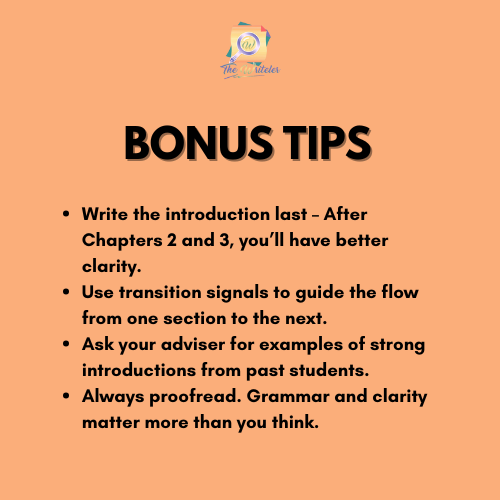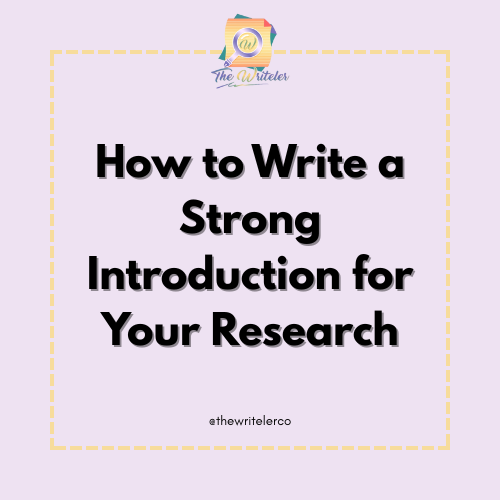Have you ever stared at a blank Word document for 15 minutes, typing and deleting the same sentence over and over again for your research?
If you’re in the early stages of your thesis, dissertation, or capstone project, the introduction can feel like the most intimidating part. But here’s a secret: once you understand the purpose and structure of Chapter 1, it becomes much easier to write.
In this blog, we’ll break down how to write a strong introduction for your research, what parts you need to include, and how to avoid the most common mistakes. Whether you’re an undergraduate, graduate student, or a busy professional taking on a master’s or Ph.D. degree — this guide is for you.
Why the Introduction Matters…
The introduction of your research is your reader’s first impression of your work. It sets the tone, explains why your topic matters, and tells your audience what to expect. Think of it as a map — if your readers are about to go on a journey through your paper, your introduction gives them the GPS.
More importantly, a strong introduction gives your panel or adviser a reason to keep reading.
Parts of a Powerful Research Introduction
1. The Hook / Background
Start with something that will pull your reader in — a surprising fact, a relevant quote, a real-life situation, or a short anecdote. This is followed by a brief background that helps your reader understand the context of your study.
Example:
“According to WHO, one in every four people worldwide will be affected by mental health issues at some point in their lives — yet mental health education remains limited in most high schools.”
2. The Research Gap / Problem Statement
After establishing context, point out what’s missing in current knowledge. This is the “why” of your study — why does your research need to exist?
Tip: Avoid being too broad. Focus on a specific problem in a specific context.
3. Objectives of the Study
What exactly are you trying to achieve? This includes:
- General Objective – the overall aim of your research.
- Specific Objectives – the small, measurable goals under the main aim.
Example:
- General: To assess the effectiveness of mindfulness techniques in reducing stress among senior high school students.
- Specific: To determine the frequency of stress, evaluate levels before and after sessions, etc.
4. Research Questions or Hypotheses
Frame your objectives as questions (for qualitative/quantitative work) or present a testable statement (for purely quantitative studies).
Example:
- “What is the impact of weekly mindfulness sessions on stress levels of SHS students?”
- OR: “Students who participate in mindfulness sessions will have significantly lower stress levels compared to those who don’t.”
5. Scope and Delimitations (Optional for Chapter 1)
This helps define the boundaries of your research: what is included, what isn’t, and why.
Example:
“This study focuses only on Grade 12 students from public schools in Quezon City and excludes private school students due to differing school environments.”
6. Significance of the Study
Who benefits from your study? This section can highlight:
- Students
- Teachers
- Policymakers
- Business sectors
- Future researchers
Make it practical. Tell readers why your work matters beyond the classroom.
Common Mistakes to Avoid
- Too broad or too vague: Get to the point quickly.
- Copy-pasted definitions: Use your own words and relate them to your topic.
- Fluff or filler sentences: Be intentional with every paragraph.
- No clear problem: If there’s no gap, there’s no need for the study.

Sample Template
Here’s a quick paragraph structure to help you get started:
In recent years, (background info). However, (identify the problem or gap). This study aims to (state objectives), specifically focusing on (scope). Through this, the research intends to contribute to (significance).
Final Checklist ✅
- Is your topic clearly introduced?
- Did you explain the relevance or urgency?
- Are the objectives clear and measurable?
- Is the tone formal and academic?
- Does it smoothly transition into Chapter 2?
You Can Now Begin With Confidence
Writing Chapter 1 might feel overwhelming, but it’s also one of the most powerful chapters in your research. It introduces your voice, your purpose, and your message.
Start clear, start strong — and let your intro be the foundation of a compelling research paper.
✅ Need Help with Your Introduction?
The Writeler Co. is here to support students and professionals who are juggling research with work, life, and business. Whether you’re writing a thesis, capstone, or dissertation for your master’s or Ph.D., we help you efficiently navigate the research journey — from brainstorming to proofreading.
📩 Message us today to get started.
📚 Let’s turn your research idea into a powerful paper.





0 Comments